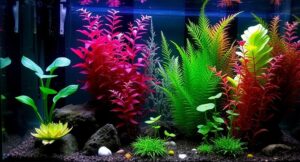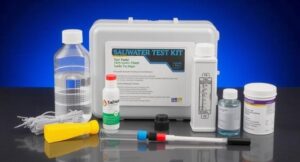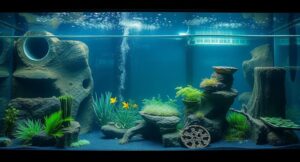Setting up a saltwater aquarium is an exciting journey, but success starts with understanding a crucial natural process: the nitrogen cycle. Without it, your tank’s beautiful fish, coral, and invertebrates won’t thrive because they’ll be living in toxic water. In this guide, we’ll break down how the nitrogen cycle works in saltwater aquariums, why it’s essential, and how to make sure your system is properly cycled before adding marine life.
What Is the Nitrogen Cycle?
The nitrogen cycle is a biological process that converts harmful waste products into less toxic substances. In a saltwater aquarium, this means turning ammonia into nitrite, and finally into nitrate. Ammonia is extremely toxic and nitrite, while less toxic than ammonia, is still very toxic. Nitrate is less harmful in small amounts.
Beneficial bacteria that reside in your live rock, sand, and filtration system generate this cycle. These bacteria are critical to the health of your aquarium’s ecosystem as they convert harmful substances are recycled into forms that plants can use.

The Three Stages of the Nitrogen Cycle in Saltwater Aquariums
1. Ammonia (NH₃) Accumulation
The cycle begins when waste accumulates and decomposes in your tank. This may be in the form of fish waste or uneaten food. This organic material breaks down and releases ammonia. Even in small amounts ammonia is extremely toxic to the marine life in your tank.
When you’re starting a new tank, ammonia can be introduced either artificially or naturally. Artificial introduction of ammonia may come from using fish food or pure ammonia. While natural introduction of ammonia may come from hardy fish. During this phase, ammonia levels spike.
Ammonia should be tested daily during this phase. This can be done by using a reliable saltwater test kit.

2. Nitrite (NO₂⁻) Formation
Next, ammonia is converted to nitrite. A type of beneficial bacteria called Nitrosomonas powers this conversion. Nitrite is slightly less toxic than ammonia, although it’s still dangerous to fish and invertebrates.
This stage can last several days to a few weeks, depending on temperature, pH, and bacterial growth rates. Your tank is still not safe for fish yet at this point.
3. Nitrate (NO₃⁻) Production
In the final stage nitrite is converted into nitrate. A second group of bacteria called Nitrobacter completes this process. Nitrates are much less toxic, but keep in mind they can still accumulate and stress fish or contribute to algae blooms if not managed.
At this point, your tank is “cycled.” You’ll still need to perform regular water changes to keep nitrate levels under control. You may consider using nitrate-absorbing media, protein skimmers, or refugiums to manage this.
How Long Does the Nitrogen Cycle Take in a Saltwater Aquarium?
The aquarium cycling process can take anywhere from 4 to 8 weeks for a saltwater tank. The exact timeline may be affected due to:
- Tank temperature (warmer water speeds up bacteria growth)
- Presence of live rock or live sand (these often contain pre-established bacteria)
- Use of bacterial starters or cycling products
- Amount of ammonia introduced
Patience is key. Never rush this process by adding fish too early—you’ll risk a tank crash and stress or kill your livestock.
How to Know When Your Saltwater Aquarium Is Fully Cycled
To confirm that the nitrogen cycle is complete, use a reef-safe test kit to monitor the values of:
- Ammonia: 0 ppm
- Nitrite: 0 ppm
- Nitrate: Low but detectable (usually under 40 ppm for fish-only tanks; under 10 ppm for reef tanks)
Once ammonia and nitrite are consistently at values of zero and nitrates are present, your tank is cycled and ready for gradual and slow stocking.
Boosting the Cycle: Tips for a Faster, Safer Start
Here are a few ways to speed up the nitrogen cycle in a saltwater aquarium:
- Use live rock or live sand: Contain established bacteria that jumpstarts the cycle.
- Add bottled bacteria: These products help establish colonies faster.
- Avoid overfeeding: More waste leads to more ammonia
- Keep the temperature stable: 77–80°F (25–27°C) for ideal bacteria growth

Why the Nitrogen Cycle Is Even More Important in Saltwater Tanks
Unlike freshwater setups, saltwater aquariums are less forgiving when it comes to water quality. Marine fish and invertebrates are extremely sensitive. This means that even minor changes in the levels of ammonia, nitrite, and nitrate levels can be detrimental to your aquarium.
Not only fish are affected by the nitrogen cycle in your aquarium. In reef tanks, corals can be especially vulnerable to spikes in nitrogen compounds. Understanding and maintaining the nitrogen cycle is essential for long-term success and the overall health of your marine ecosystem.
Final Thoughts: Respect the Cycle
The nitrogen cycle in saltwater aquariums is the foundation of a healthy tank. Taking the time to cycle properly and monitor your water parameters regularly is essential. By doing this you’re setting your system up for stability, beauty, and longevity.
Cycling isn’t just a one-time process it’s a continuous balance that every aquarist must manage. Whether you’re setting up a nano reef or a full-size marine tank, respecting the cycle is the key to keeping your saltwater environment healthy and your marine life happy.


